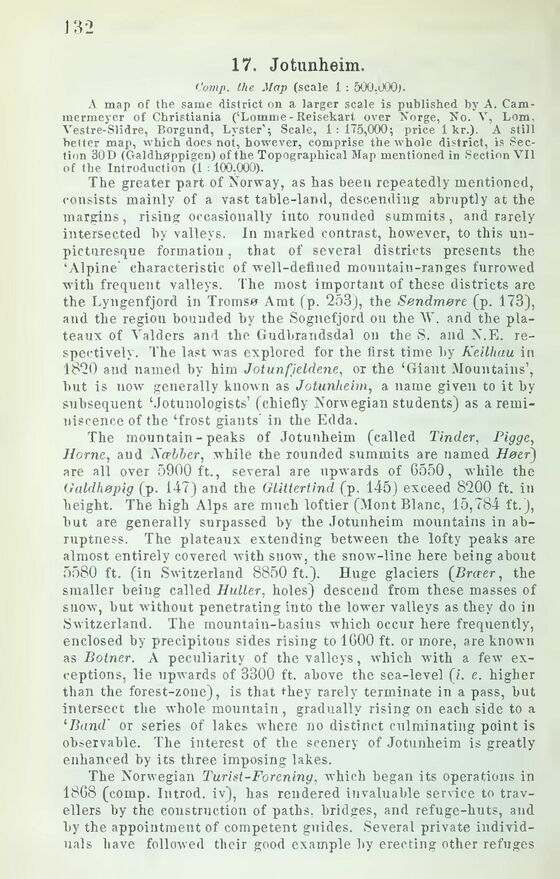
Full resolution (JPEG) - On this page / på denna sida - Norway - Pages ...

<< prev. page << föreg. sida << >> nästa sida >> next page >>
Below is the raw OCR text
from the above scanned image.
Do you see an error? Proofread the page now!
Här nedan syns maskintolkade texten från faksimilbilden ovan.
Ser du något fel? Korrekturläs sidan nu!
This page has never been proofread. / Denna sida har aldrig korrekturlästs.
J32
17. Jo tunheim.
Comp, the Map (scale 1 : 500,000).
A map of the same district on a larger scale is published by A.
Cam-inermeyer of Christiania (‘Lomme - Reisekart over Norge, No. V, Lorn,
Vestre-Slidre, Borgund, Lyster’; Scale, 1:175,000; price 1 kr.). A still
better map, which does not, however, comprise the whole district, is
Section 30D (Galdhøppigen) of the Topographical Map mentioned in Section VII
of the Introduction (1 : 100,000).
The greater part of Norway, as has been repeatedly mentioned,
consists mainly of a vast table-land, descending abruptly at the
margins, rising occasionally into rounded summits, and rarely
intersected by valleys. In marked contrast, however, to this
un-pictnresque formation, that of several districts presents the
’Alpine’ characteristic of well-defined mountain-ranges furrowed
with frequent valleys. The most important of these districts are
the Lyngenfjord in Tromsø Amt (p. 253), the Sendmere (p. 173),
and the region hounded by the Sognefjord on the 4V. and the
plateaux of Valders and the Gudbrandsdal on the S. and N.E.
respectively. The last was explored for the first time by Keilhau in
1820 and named by him Jotunfjeldene, or the ‘Giant Mountains’,
but is now generally known as Jotunheim, a name given to it by
subsequent ‘Jotunologists’ (chiefly Norwegian students) as a
reminiscence of the ‘frost giants" in the Edda.
The mountain-peaks of Jotunheim (called Tinder, Pigge,
Horne, and Xabber, while the rounded summits are named Heter)
are all over 5900 ft., several are upwards of 6550, while the
Galdhepig (p. 147) and the Glittertind (p. 145) exceed 8200 ft. in
height. The high Alps are much loftier (Mont Blanc, 15,784 ft.),
but are generally surpassed by the Jotunheim mountains in
abruptness. The plateaux extending between the lofty peaks are
almost entirely covered with snow, the snow-line here being about
5580 ft. (in Switzerland 8850 ft.). Huge glaciers {Braer, the
smaller being called Huller, holes) descend from these masses of
snow, but without penetrating into the lower valleys as they do in
Switzerland. The mountain-basins which occur here frequently,
enclosed by precipitous sides rising to 1600 ft. or more, are known
as Botner. A peculiarity of the valleys, which with a few
exceptions, lie upwards of 3300 ft. above the sea-level (i. e. higher
than the forest-zone), is that they rarely terminate in a pass, hut
intersect the whole mountain, gradually rising on each side to a
lBand’ or series of lakes where no distinct culminating point is
observable. The interest of the scenery of Jotunheim is greatly
enhanced by its three imposing lakes.
The Norwegian Turist-Forening, which began its operations in
1868 (comp. Introd. iv), has rendered invaluable service to
travellers by the construction of paths, bridges, and refuge-huts, and
by the appointment of competent guides. Several private
individuals have followed their good example by erecting other refuges
<< prev. page << föreg. sida << >> nästa sida >> next page >>